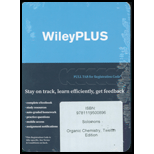
Interpretation:
The reaction mechanism for the formation of methyl cyclopentene from 1-cyclobutylethanol is to be outlined.
Concept introduction:
Carbocation is a molecule having a carbon atom bearing three bonds and a positive formal charge.
Carbocation are generally unstable because they do not have eight electrons to satisfy the octet rule.
The dehydration of alcohols includes in the first step, the protonation of alcohol and the formation of carbocation.
The order of stability of carbocation is such that the tertiary carbocation is the most stable whereas the primary carbocation is the least stable, and secondary carbocation lies between primary and tertiary carbocations.
If primary carbocation is obtained in product, it rearranges itself to secondary or tertiary carbocation to form more stable product.
If secondary carbocation is obtained in product, it rearranges itself to tertiary carbocation to form more stable product.
Want to see the full answer?
Check out a sample textbook solution
Chapter 7 Solutions
ORGANIC CHEMISTRY-WILEYPLUS ACCESS PKG.
- Nonconjugated , -unsaturated ketones, such as 3-cyclohexenone, are in an acid-catalyzed equilibrium with their conjugated , -unsaturated isomers. Propose a mechanism for this isomerization.arrow_forwardWrite a mechanism that accounts for the formation of ethyl isopropyl ether as one of the products in the following reaction. CI OEt HCI EtOH Write the mechanism for step one of this reaction. Show lone pairs and formal charges. Only the acidic hydrogen should be drawn out with a covalent bond. Write the mechanism for step two of this reaction (where the product of step one reacts with the solvent, ethanol). Show lone pairs and formal charges. Only the acidic hydrogen should be drawn out with a covalent bond. Write the mechanism for the last step of this reaction (formation of ethyl isopropyl ether). Show lone pairs and formal charges. Only the acidic hydrogen should be drawn out with a covalent bond. CI will act as the base in this reaction.arrow_forwardA carbamate can be prepared by treating an isocyanate with an alcohol, as shown here. This type of reaction is used to synthesize polyurethanes- polymers that have a wide variety of industrial applications, such as surface sealants, high-performance adhesives, and synthetic fibers. Propose a mechanism for this transformation. R'—ОН R. `N=C=0 R. OR' An isocyanate A carbamate (Substituted urethane) O=Carrow_forward
- When 2-methylpent-2-eno reacts with HCl two alkyl halides are formed. Present the structures of the formed products and propose a mechanism that explains the formation of these products. Indicate the main product.arrow_forwardPredict the b-elimination product(s) formed when each bromoalkane is treated with sodium ethoxide in ethanol. If two or more products might be formed, predict which is the major productarrow_forwardWhen ethoxybenzene is treated with a mixture of nitric acid and sulfuric acid, two products are obtained, each of which has the molecular formula C8H9NO3. For the mechanism, draw the curved arrows as needed. Include lone pairs and charges in your answer. Do not draw out any hydrogen explicitly in your products. Do not use abbreviations such as Me or Ph.arrow_forward
- When trans-2-chloro-1-cyclohexanol is treated with a base, cyclohexene oxide is the product. However, when cis-2-chloro-1-cyclohexanol is treated with a base, the product is cyclohexanone. Write the mechanism for each of the two reactions.arrow_forwardThe reaction of (S)-2-bromopentane with potassium cyanide to yield 2-methylpentanenitrile (2-cyanopentane) occurs via a nucleophilic substitution pathway. The reaction is 100% stereospecific.arrow_forwardGive all the monobromination products of 2-methylpropane (or isobutane) in presence of heat or energy. Identify the major product and propose a mechanism leading to the formation of the major product. Provide a reaction in the termination step.arrow_forward
- When A is reacted with hot aqueous NaOH, a compound B of molecular formula C8H11NO is produced. With this information, write the correct structure of B and propose the reaction mechanism (step by step, with the correct use of arrows) to obtain B.arrow_forwardA synthetic organic molecule, G, which contains both aldehyde and ether functional groups, is subjected to a series of reactions in a multi-step synthesis pathway. In the first step, G undergoes a Wittig reaction, leading to the formation of an alkene, H. Subsequently, H is treated with an ozone (O3) reagent followed by a reducing agent in an ozonolysis reaction, resulting in the formation of two different products, I and J. Considering the functional groups present in G and the nature of the reactions involved, what are the most probable structures or functional groups present in products I and J? A. I contains a carboxylic acid group, and J contains an aldehyde group. B. I contains a ketone group, and J contains an alcohol group. C. I and J both contain aldehyde groups. D. I contains an ester group, and J contains a ketone group. Don't use chat gpt.arrow_forwardSketch the reaction mechanism (including the final product) corresponding to the following description. Be prepared to explain the mechanism to your partner. 2-bromo-4-methylpentane is being reacted with sodium cyanide in diethyl ether (set up the reaction – next you will get a description of the mechanism to draw). A lone pair of electrons from the cyanide attacks the carbon bonded to bromine, forming a new carbon-carbon bond. At the same time, the carbon-bromine bond breaks with the electron pair from the carbon-bromine bond moving toward the bromine to form a bromide ion. This will form the product 2,4-dimethylpentanenitrile and sodium bromide. is this reaction following an SN1 or SN2 mechanism? Write out the rate law for this reaction.Draw a reaction coordinate diagram for this reaction.arrow_forward
